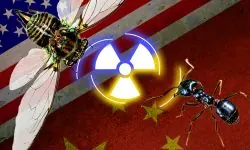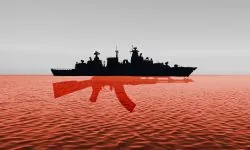(Art direction and design: Jean-Dominique Lavoix-Carli)
Given the speed and political density of the historic sequence opened by the war in Gaza, this third article only covers the period from 20 October 2023 to 10 February 2024.
In December 2023, the Pentagon launched Operation Prosperity Guardian in the Red Sea. The operation is the U.S. military reaction to the Yemeni Houthi war in the Red Sea (Sam Lagrone, “”Operation Prosperity Guardian” set to protect ships in the Red Sea, Carrier IKE in Gulf of Aden”, U.S. Naval Institute, 18 December 2023).
- DeepSeek vs Stargate – China’s Offensive on U.S. AI Dominance?

- Trump Geopolitics – 1: Trump as the AI Power President

- Uranium for the U.S. Nuclear Renaissance – 2: Towards a global geopolitical race

- The New Space Race (1) – The BRICS and Space Mining

- Uranium for the U.S. Nuclear Renaissance – 1: Meeting Unprecedented Requirements

This operation is based on the creation of a combined naval task force, mainly with elements of the U.S. and of the UK navies, while the Houthis’ guerrilla war at sea becomes more and more intense.
In other words, the extension of the Gaza war in the Red Sea area through the Houthis offensive is triggering the emergence of a whole new theatre of operations. The Red Sea becomes the attractor for the U.S. and U.K navies, for the Houthis operations, while the international traffic of cargoes is at stake.
In the same dynamic, the Houthis’ targets of choice besides the Russian and Chinese they choose not to target reveal how a rapidly emerging multipolarity is becoming a regional reality.
This situation is even more disruptive for the West and for globalisation because the Red Sea war sees the Somali piracy reaching a new peak of activity in the Gulf of Aden, which opens up on the Bab-el-Mandeb Strait and the Red Sea.
Indeed, the Houthi Ansar Allah militia officially started their operations in solidarity with the Palestinians and against Israel and its allies. Their forces launched salvos of missiles and drones on Israel. They began attacking civil or military ships with their speed boats flotilla. They also used helicopters and mini submarines (Tara Copp and Lolita C. Baldor, “US Military shoots down missiles and drones as it faces growing threats in volatile Middle East”, AP, 20 October 2023). On 27 October, another missiles’ salvo failed to reach Israel (Michael Horton, “Houti missiles launches against Israel risk reigniting war in Yemen”, Responsible Statecraft, October 30, 2023).
The name “Operation Prosperity Guardian” is a clear reference to the global trade disruption induced by the Houthi’s continuous offensive. Indeed, several major shipping companies such as Danish Maersk, French CMA-CGM and Taiwanese Evergreen had to order their ships to avoid the Red Sea crossing. However, the Red Sea being a major maritime artery, those decisions increase the costs and duration of the cargo journey.
This triggered shockwaves through global logistical supply chains, while increasing costs for companies and customers (Simon Scarr, Adolfo Arranz, Jonathan Saul, Han Huang and Jitesh Chowdhury, “Red Sea attacks – How Houthi militants in Yemen are attacking ships in one of the busiest maritime trade routes”, Reuters, February 2, 2024).
The Red Sea War : a case study in asymmetric warfare
In other words, the Red Sea war reveals that the houthis guerrillas are becoming a regional power in the Middle East. Furthermore, they develop the capability to be disruptive on a global scale. This transformation, from a land militia into a regional strategic land and sea power necessitates to understand the Houthis strategy at different levels, from the level of the war in Gaza to the level of the Yemen regional war and of the Middle East conflict between Saudi Arabia and Iran, including the interactions with the US military presence in the region.
This naval war also reveals how this asymmetry plays itself not only at the military level of the “weak” Houthis against the “strong” U.S. and UK navies, but also in the media-political-symbolic dimension of what we call “performative warfare”, as well as in the financial dimension of the costs of weapons systems. This latter dimension being awfully in favour of the “poor and weak” Houthis.
Thus, the Red Sea war reveals how major western powers are in dire difficulties when confronting a naval guerrilla that installs its activities on the long run. This naval war of the weak to the poor prolongs itself with the return of Somali pirates in the Gulf of Aden. Indeed, the latter’s actions reach a peak of activity not seen in years. As it happens, their renewed presence literally “complements” the Houthi’s naval warfare and sea power.
This synergy of the Houthis and Somali pirates sea power reveals the essence of the Red Sea war asymmetric character (Lawrence Freedman, The Future of War: a History, Penguin Books, 2017). It is a fight between a very powerful military machine – the U.S. and its allies – and a militia from a desperately poor country, added to pirates from a no less poor country.
Those warriors emerge from an extreme environment defined by one of the worst civil war on Earth. And they redefine the meaning of victory: to them, victory appears as installing their operations from the short to the middle term, while for Operation Prosperity Guardian, victory would mean eliminating the means of action of the Houthis.
In order to study the different layers of strategic meaning of the Red Sea war, we shall start by understanding how the Yemeni civil and regional war prolongs itself in the Red Sea at the occasion of the war in Gaza, and how the Houthis mobilize different levels of tactics and strategies.
Then, we shall see how the Houthi guerrilla has learned asymmetric warfare through a long war in a country ravaged by the combination of a 20 years long civil war, climate change and pandemic.
Then we shall see how the “asymmetric sea power” of the weak is reinforced by the added “poor sea power” of the Somali pirates and how globalization is thus put at risk by the emergence of this new kind of “weak but highly disruptive” sea power.
War on the Red Sea: convergence of wars, convergence of tactics
Since 20 October 2023, the Houthi militia has launched salvos of missiles from Yemen across the Red Sea, trying to strike Israel. U.S. warships intercepted and destroyed those missiles.
Since then the number of Houthis strikes and attacks has grown ceaselessly. coinciding with the Israeli military built up and the offensive against Hamas in Gaza that lasts since the 28 October (Jean-Michel Valantin, “The war in Gaza and China’s pivot to the Middle East”, The Red Team Analysis Society, November 22, 2023).
Who Rules the Red Sea, Rules Globalization
As it happens, the Red Sea is one of the most important maritime routes on Earth. It is home to two crucial global chokepoints. To the north, the Suez Canal links the Mediterranean Sea, the Middle East, Europe and the Atlantic Ocean, to the Red Sea. To the south, the Bab-El-Mandeb strait links the Red Sea to the Gulf of Aden, the Arabian sea, the Indian Ocean, East Africa and South and South-East Asia.
If the Red Sea represents 10% of the international maritime traffic, it also accounts for 30% of container traffic. Those have a total value of 1000 billion dollars each year. In other terms, the Red Sea is the main artery of globalization. The freedom and security of circulation on this waterway is crucial for global trade and for global supply chains (Ariel Cohen, “The world is going into the red from the Red Sea Crisis”, Forbes, February 7, 2024, and Thibault Denamiel, Matthew Shleish, William Alan Reinsch, and Will Todman, “The global economic consequences of the attacks on the Red Sea Shipping lanes”, CSIS, January 2024).
It is also the case in the energy sector. Around 75 oil and gas tankers use the Red Sea daily. They deliver products from the Persian Gulf to Europe, or from Russia to India (Denamiel et al., ibid).
In this heated geopolitical context, the Houthi political authorities claimed they launched strikes in solidarity with Palestinians in Gaza (Lori Ann Larocco, “As more tankers divert from Red Sea, there’s a “sea change” in way Europe is buying crude”, CNBC, January 24, 2024).
The Long March of the Houthis
Nevertheless, from a historical perspective, the Houthis operations in the Red Sea may very well appear as a continuation at sea of the twenty years long Yemeni civil and regional war. As it happens, the Yemeni civil war really started in 2004. Then, the NorthWest Shia Yemeni Houthi minority demanded to be fairly treated by the regime of President Saleh. The latter replied with a heavy campaign of repression. A civil war soon followed (Dr Abdo Albahesh, “The Houthi movement in Yemen: from insurgency to military coup, 2004-2014“, Medium, Oct. 23, 2018).
The support of Iran, as well as the Houthi own excellent strategists allowed the Houthi militia to multiply successes. In January 2015, the Houthi militia seized Sanaa, the Yemen capital, forcing then president Abd Rabbo Mansour Abdi to flee to Aden (Jeremy Scahill, Dirty Wars, The World is a Battlefield, Nation Books, 2013 and Marcus Montgomery, “A Timeline of the Yemen’s crisis from 1990 to the present”, Arab Centre Washington D.C., February 19, 2021, and Kali Robinson, “Yemen’s tragedy, War, Stalemate and Suffering”, Council on Foreign Relations, last updated May 1, 2023).
During the following weeks, this Houthi victory led Saudi Crown Prince Mohammed bin Salman to gather a military coalition against them. This coalition gathered the United Arab Emirates (UAE) and Kuwait.
Their goal was to prevent the victory of Iran-allied Houthis in the immediate neighbourhood of Saudi Arabia. One must also keep in mind that Yemen literally commands the Bab-El-Mandeb Strait (Bruce Riedel, “Yemen’s war shakes up the Saudi palace”, Brookings institution, April 2019, 2015).
Apocalypse Yemen
From 2015 to 30 March 2022, Saudi Arabia launched its troops in Yemen. Meanwhile, the UAE supported this offensive with hundreds of Columbian and U.S. mercenaries. The Emirati also hired 15.000 Sudanese soldiers alongside Saudi forces. The Saudi-led coalition also benefitted from the strong support of the U.S. Navy and special forces. The UK and French militaries provided too technical and training assistance and ammunitions contracts (“Guerre civile yéménite“, Wikipedia and Andrew Bacevich, America’s War for the Greater Middle east, A Military history, Random House, 2016).
Furthermore, since 2004, the intensity of the Yemeni war has combined with a series of drought and famines in the country. This war and climate extreme events nexus killed hundreds of thousands of people through hunger, thirst, displacements, bombings, combats and epidemics. So, in twenty years, Yemen turned into one of the deadliest places on Earth (“Starvation stalks Nigeria, Somalia, South Sudan, Yemen”, Al Jazeera, 11 April 2017.
On the opposite side, Iran is said to support the Houthis. The Iran Revolutionary Guard Corp (IRCG) organizes the weapons, military and technical training (Katherine Zimmerman, “Yemen’s Houthis and the expansion of Iran’s axis of resistance”, American Enterprise Institute, 2022).
Technical training is essential in order to assemble ground-to-ground and ground-to-sea missiles. Still, according to the UN, North Korea would also have provided combat drones ( David Axe, “The Houthis might be using North Korea missiles”, The National Interest, November 4, 2021, Samuel Ramani, “The North Korea-Iran relationship: an anti-american axis or a transactional partnership?”, 38 North, 24 November 2021).
A Houthi’s multilevel strategy ?
Since 2022, the string of Houthi victories has achieved a suspension of the hostilities between the Houthis and the Saudi-led coalition.
So, from a geopolitical perspective, we can hypothesize that the current Houthi attacks against Israel, then against passing cargo ships and U.S. and UK warships may very well appear as a multilevel strategy. Indeed, the Yemen political and military authorities state their support to the Palestinians as soon as 20 October, when they initiate their first tentative strikes against Israel. Yet, one cannot help noticing that these strikes, then the multiple air and sea attacks against commercial and military warships in the Red Sea have strictly no military or political incidence on the way Tsahal or Hamas wage the war in Gaza.
However, from the Houthi strategic point of view, Israel also appears as an ally of the United States. And the U.S. are both militarily and politically committed against both Houthis and Iran, their main supporter (Ibrahim Jalal, “The Houthis Red Sea missile and drone attack: drivers and implications”, Middle East Institute, 20 October, 2023).
Furthermore, waging a “claimed” war against Israel, while waging a real naval war against the U.S. and the UK Navies, while disrupting one of the main arteries of globalization, elevates the geopolitical and strategic status of the Houthi militia to the status of ascending regional power.
This new regional power thus supports the Iranian influence from the Persian Gulf to the Red Sea, while containing the Saudi influence (Fatima Abo Alasrar, “From Yemen to Palestine: the strategic depth of the Houthi-Iranian alliance“, Middle East Institute, February 16, 2024). Thus, the Houthis militia affirms itself as a literally pivotal power in one of the most important energy and transport region in the world.
So, in a very practical way, the stated level of military solidarity with the Palestinians and its consequent attacks induces the positioning of U.S. and Israeli destroyers in the Red Sea, in order to intercept the Houthis missiles and drones, while becoming occasional targets for the militia (Ibrahim Jalal, “The Houthis Red Sea missile and drone attack: drivers and implications”, Middle East Institute, 20 October, 2023 and John Gambrell, “Houthi rebels fire missile at US warship, escalating worst Middle East sea in decades“, PBS, January 27, 2024 ).
Indeed, when the Houthis started bombing Israel, the U.S. and UK Navies, i.e. the military allies of the enemies of the Ansar Allah / Houthi militia, were attracted in the Red Sea.
Hence, the intensification of the Houthi campaign and attacks against U.S. warships may very well also be understood as a continuation and an extension of the Yemeni regional war at sea (“Houthis target U.S destroyer in latest round of missiles attack; strike British merchant ship”, CBS News, January 27, Jana Choukeir and Nadine Awadalla, “Yemen Houthis threaten more attacks on US, UK warships”, Reuters, January 31, 2024).
Asymmetric warfare as geoeconomic warfare…
This confrontation of the Houthis versus U.S. and U.K navies triggers a strange technological and economic warfare. Indeed, the drones the Houthis use cost only 2.000 $ and the missiles cost about 100.000 $. However, the western warship use hardware costing from 1 million $ to 4 million $ to destroy the Houthis low-tech drones and missiles (Lara Seligman and Matt Berg, “A $2M missile vs a $2000 drone: Pentagon worried over cost of Houthi attacks”, Politico, December 12, 2023).
Then, as of this writing, since December 2023 the U.S./UK maritime combined force launched three bombings campaigns against Houthi bases and installations. However, basically, those bombings only destroy low-tech hardware such as pick-ups, easily replaceable missiles ramps, etc.
Then, the maritime operations against the very agile Ansar Allah speed boats fleet mobilizes combat helicopters and important tactical resources (Simon Scarr, Adolfo Arranz, Jonathan Saul, Han Huang and Jitesh Chowdhury, “Red Sea attacks – How Houthi militants in Yemen are attacking ships in one of the busiest maritime trade routes”, Reuters, February 2, 2024). However, these high level and very costly military means are unable to deter the sea attacks.
… and performative warfare
The Houthis reinforce their strategic and political efficiency through performative warfare. As did Hamas when attacking Israel during the monstrous massacre of 7 Octobre 2023, and during the subsequent Gaza battles, this strategy rests on the filming and transmission by the U.S. and UK medias of the missiles and drones salvos (Jean-Michel Valantin, “The war in Gaza and China’s pivot to the Middle East”, The Red Team Analysis Society, November 22, 2023).
The same approach is used to film the damages of the bombing campaigns on Yemeni ground. Those salvoes of videos orient perceptions on the suffering of Yemeni civilians. They also aim to create a framework of perception on how those bombings achieve very little in tactical or operational terms.
This media and information warfare projects the Houthi influence upon the global audience, while diminishing the charisma of the U.S. military power (Matthew Ford and Andrew Hoskins, Radical War, Data, Attention and Control in the 21st Century, Hurst Publishing, 2022).
The Place to Be
To add insult to injury, on 19 November 2023, a Houthi commando used a helicopter taken to the Yemeni government to hijack the passing cargo Galaxy leader.
Once taken, the ship became a kind of “Houthis maritime theme park”. It is now a touristic destination for Houthis militiamen, Houthis influencers, Yemeni families, etc ( FP Staff, “Pirate Park: Yemen Houthis convert Galaxy Leader into tourist attraction at 1$ per visit”, Firstpost, 29 January, 2024). Multiple videos of dancing warriors, tourists and parties launched with the crew are downloaded on social networks.
This performative strategy has a politically corrosive effect. Indeed, from a global perception point of view, it turns the forces that constitute Operation Prosperity Guardian into lumbering and powerless giants. Reciprocally, the small and agile forces of the Shia militia are shown as imposing tremendous costs to First World military great powers.
Taking time as victory
In this situation, the definition of victory is not military any more, but performative. So, the longer the “strategic reality show” of the humiliation of military great powers by militiamen from an Arab and lethally violent and poor country is, the more stunning the “long victory” becomes (Matthew Ford and Andrew Hoskins, Radical War, Data, Attention and Control in the 21st Century, Hurst Publishing, 2022).
Disrupting globalization…
Furthermore, this military-symbolic performative warfare goes hand in hand with a very efficient geo-economic strategy. As it happens, turning the Red Sea into a naval battle zone incites major shipowners such as Maersk or CMA-CGM to order their ships to avoid the Red Sea.
This forces ships to make a diversion around the Cap of Good Hope, lenghtening their journey while increasing costs (Tyler Durden, “Red Sea crisis send Maersk shares crashing as outlook darkens, Buybacks suspended”, ZeroHedge, February 8, 2024).
… But which globalization ?
However, Russian and Chinese ships, especially tankers, obtain a de facto safe-conduct, provided they have no business with Israel. So, Russian oil exports to China and India have safe passage. However, the Saudi, Iraq, Qatari and Kuweiti oil and LNG tankers take a longer road around the Cap of Good Hope (Michelle Wiese Bockmann, “Russia oil exports uninterrupted by mounting Houthi attacks on the Red Sea”, Lloyd’s List, 10 January 2024).
The vessels that have to use the longer route around Africa and the Cap of Good Hope have to pay larger fuel expenses, as well higher costs for containers leasing. Those that dare to use the Red Sea waterway have to pay huge premium insurance rates. Meanwhile, chronic supply chain disruption is taking hold in Europe (Thibault Denamiel, Matthew Shleish, William Alan Reinsch, and Will Todman, “The global economic consequences of the attacks on the Red Sea Shipping lanes”, CSIS, January 2024).
In other words, the Houthis successfully target Western supply chains. They also demonstrate that they are now a regional power with which other powers must reckon.
No westerners allowed
It is in this context that, on 19 January 2024, Mohamed Al Bukhaiti, a senior member of the Houthi command hierarchy, declared that the militia would not harm Russian and Chinese ships, if they were not involved with Israel (“Houthis won’t target Russian, Chinese ships in the Red Sea”, Voice of America, January 19, 2024).
This declaration confers a wider strategic meaning to the situation that a “simple” support of the Iran-backed militia to the Palestinian Hamas. Through this declaration, Mohamed Al Bukhaiti unveils the greater geopolitical landscape of the Red Sea war.
With this statement, the Houthis define the geopolitical meaning of their Red Sea operations as a war against the western supporters of Israel, but not against China and Russia. Thus, China’s and Russia’s ships acquire the strategic status of “protected navies” by the Houthis. So, implicitly, from the Houthis’ perspective, the status of China and Russia is one of “non-aligned” or “passive supporters”, or even “implicit allies” (Jean-Michel Valantin, “From the War in Gaza to the Great U.S-China War ? (2) “, The Red Team Analysis Society, December 26, 2023). On the opposite side, the members of Operation Prosperity Guardian are enemies that must know defeat.
As it happens, the efficiency of the military, geopolitical and geo-economic disruption wrought by the Houthis is optimized by the way a network of Middle Eastern non-state militias are attacking U.S. forces.
The warriors from Hell
Let’s get some Americans
As soon as 9 October 2023, i.e. two days after the horrendous massacre by Hamas in Israel, the U.S. White House, as well as the Pentagon warned the Lebanese Hezbollah, as well as Iran, not to get involved in the conflict opposing the Israeli defense force against Hamas in the Gaza strip (Jared Szuba, “Pentagon warns Iran, Hezbollah to stay out of Hamas war with Israel”, Al Monitor, October 10, 2023).
However, if, as of this writing, Hezbollah and Iran indeed appear officially to involve themselves only politically but not militarily in the Gaza crisis, there is nonetheless a proliferation of attacks against U.S. bases and military staffs. Multiple Iraqi and Syrian militias, more or less allied with the Iranian Islamic Revolution Guardian Corps, lead those attacks.
In order to retaliate, the U.S. forces launched bombing campaigns in Syria, Iraq and Yemen (Michael Dimino, “Bombing is not the only way out of the Houthi crisis”, Responsible Statecraft, 29 January, 2024 and Balint Szlanko, “What to know about the US strikes in Iraq and Syria, and its attacks with the UK in Yemen ?”, AP, 4 February, 2024.
However, there is an obvious firepower asymmetry between the formidable military machinery of the U.S. forces and the Houthis militia as well as the multiple militias in Iraq and Syria. And how is it that they reach an indisputable asymmetric level of success? (Stephen Biddle, Nonstate Warfare, the military methods of guerrillas, warlords, and militias, Princeton, Princeton University Press, 2021).
The Houthis and the struggle for life
It has been twenty years that the Houthi militia is waging both civil and international war. It has had to fight the Saleh regime and its successors. They also survived the fight against Saudi troops, Colombian, U.S., British and Sudanese mercenaries and special forces, as well as against the U.S. Navy.
This long war takes place in one of the most arid countries on Earth. In Yemen, heat, drought and inhuman heatwaves driven by climate change exert a terrible pressure upon agriculture, while depleting water resources (Cedric de Coning and Florian Krampe, “Climate, peace and security fact sheet : Yemen”, Norwegian Institute of International Affairs (NUPI) and the Stockholm International Peace Research Institute (SIPRI), June 2023. The climate and war induced famines and epidemics, especially cholera, have killed hundreds of thousands of people (377.000 by UN estimates at the end of 2022, Yemen: Why is the war there getting more violent? – BBC News).
In other words, the Yemeni civil and regional war takes place in a zone of collapse (Jean-Michel Valantin, “Will there be climate civil wars?”, The Red Team Analysis Society, November 30, 2021 and Harald Welzer, Climate wars: what people will be killed for in the 21st century, 2012)
What doesn’t kill the Houthis…
Hence, in the Red Sea, the U.S. and UK navies try to confront one of the most robust and resilient non-state military actor in the world, on its way to probably become a state.
The long war they have been waging has trained them to develop the necessary stamina for a protracted naval war. Meanwhile, their political authorities know that that the military and political U.S. habitus is short-term victory oriented.
As it happens, in 2024, the U.S. strategic staying power may be even shorter than usual. Indeed, the U.S. presidential election campaign already impacts the U.S. commitment in the Middle East (Mark Weisbrot, “A widening war in the Middle east could alter election results”, Centre for Economic and Policy research, January 29, 2024).
Sea power from Mad Max Land
If Yemen commands the Bab-el-Mandeb Strait, the Gulf of Aden, which joins that strait to the Sea of Arabia, is commanded by Somalia. As it happens, the Somalian littoral hosts several fishermen’s communities turned pirates since the turn of the 21st century.
Those pirates attack all kinds of ships. They stop them and take the crews as hostages. Through a twenty years long experience, Somali pirates know how to exact very significant ransoms from governments and private shipping companies (Jean-Michel Valantin, “Somali Piracy: a model for tomorrow’s life in the Anthropocene?”, The Red Team Analysis Society, 28 October, 2013).
And it appears that, since the start of the Houthi’s Red Sea war, the Somali pirates are on the offensive again. The Somali piracy is reaching a level of activity not seen since 2017 (Lori Ann Larocco, “Somali pirates are back on the attack at a level not seen in years, adding to global shipping threats”, CNBC, February 6, 2024 .
The Somali pirates strike back
For example, at the peak of pirates attacks in 2009, they exacted more than 58 millions dollars through ransoms. Their learning and efficiency curve allowed them to reach 238 millions dollars in 2010 (Oceans beyond Piracy, The Economic Cost of Piracy).
Starting with the beginning of the 21st century (Parenti, Tropic of Chaos, 2011) Somali piracy’s home-made, small-scale tradecraft has been a tentative reconversion of a few (very) poor Somali fishermen. It quickly became an industrial activity, generating tens to hundreds of millions of dollars a year. Thanks to these financial successes, the pirate fleets became progressively better equipped and armed through the years. Those better conditions allow them to go farther and farther away in the Indian ocean (Valin, EchoGeo, 2009).
So, they turned a whole swathe of the Indian Ocean into a “pirates lake”. The consequent pressure led major financial actors such as the members of the insurance market, e.g. Lloyd’s, to raise insurance premiums. In 2012, those new costs reached five to six billion dollars that global trade had to bear (Tim Bailey, Thiemo Fetzer, Hannes Mueller, “The economic costs of piracy”, International Growth Centre, April 2012).
Since 2002, European, US, Russian and Asian governments have had to divert some of their Navies in the region, integrating their naval forces, for example through the “combined task to force 150”.
Combined Task Force 150 got finally efficient and imposed a strong reduction of the Somali piartes activity. However, after a steady decrease in activity between 2012 and 2017, in 2018, Somali pirates were back and even hijacked a cargo, starting again kidnapping, ransoming, etc… (Abdi Latif Dahir, “Piracy made a strong come back in Somalia in 2017”, Quartz, May 24 2018).
Piracy as a (successful) survival strategy
This is explained by the fact that the original causes of the Somali piracy phenomenon, i.e the overfishing of Somali waters by foreign industrial fleets, poverty, failing agriculture due to climate change induced drought, youth without any future, are becoming worse than at the start of the 21st century (Ian Urbina, The Outlaw Sea, Crime and Survival in the Last Untamed Frontier, 2019).
Then, following the start of the 2023-24 Red Sea War, the Somali pirates became more and more active. The reason for this probably resides in the fact that a part of the anti-piracy capabilities that were deployed in the Gulf of Aden have been recalled or are mobilized by the Operation Prosperity Guardian. In order to fight the pirates, the French navy has positioned three warships in and out of the Gulf of Aden (Lori Ann Larocco, ibid).
As it happens, the Somali pirates emerge from a nexus of “military and collapse Darwinism” that is very close to the one endured by Houthis (for the idea of “military Darwinism”, David Kilcullen, The Dragons and the Snakes, How the Rest Learned to fight the West, Hurst, 2020). Their “evolutionary artificial” pathway led them to raid the Red Sea and the Gulf of Aden, with such efficiency that multiple great and regional powers had to combine their maritime strength against them (Ibid.).
The Mad Max Axis
In the Western world, “armies and navies from the wasteland” are only known on screen through the movies of the Mad Max saga.
This series of dystopian movies describes hordes of road warrior fighting each others in a world ravaged by war, climate change and state collapse.
However, what is the fiction of Western movies is the dire reality of Yemen and Somalia. Those collapse zones literally become selective evolutionary systems from which emerge the armies for which asymmetric warfare is their way of life and survival as well as their strategic advantage, in a situation of virtual breakdown of civilization (Hélène Lavoix, “How to create new civilizations (2): Creation and Mimesis”, The Red Team Analysis Society, 15 January, 2024).
In other terms, the convergence of the Houthis war on the Red Sea and of the new rise of Somali piracy leads to the emergence of a bipolar Houthis-Somali pirates asymmetric sea power. This “sea power from Mad Max Land” endangers the maritime dimension of Western globalization. In the same dynamic, it is dragging modern and powerful navies into a protracted, politically and financially exhausting fight.
It now remains to be seen how this coalescence of the Gaza war, of the Red Sea war and of the multiple asymmetric guerrillas taking place in the Middle East against the U.S. military is going to lead, or not, to a regional escalation towards a full scale conflict, or not.








Thank you for your hard work !